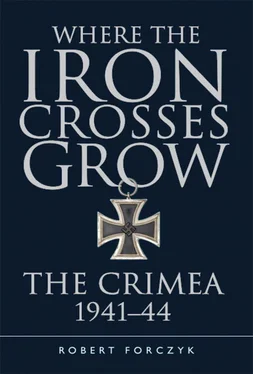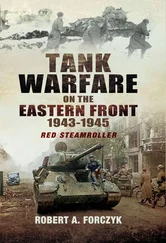A number of cargo ships were pressed into evacuating civilians and military wounded from the Crimea ports to Novorossiysk, but Levchenko made little effort to coordinate this effort or to ensure proper air cover and naval escorts. Since Levchenko did not believe that Sevastopol could be held for very long, he permitted the entire medical staff of the Black Sea Fleet to board the 5,770-ton freighter Armeniya , which left Sevastopol on the evening of November 6. The Armeniya also carried thousands of wounded, and stopped briefly in Balaklava to pick up NKVD personnel. The vessel might have made it to safety had not Communist Party officials radioed for it to dock at Yalta to pick up local politicians, their families, and Komsomol members. Six hours were spent waiting in Yalta for the last people to arrive, by which time the sun was up. The VVS-ChF provided two I-153 fighters as token cover over the Armeniya as it left Yalta and the fleet sent two MO-IV sub-chasers to act as escort. However, Luftwaffe reconnaissance aircraft quickly spotted the Armeniya , and an He-111 bomber from 1./KG 28 attacked at 1125hrs. A single aerial-delivered torpedo struck the ship’s bow, tearing it off. Within four minutes, the ship plunged to the bottom of the Black Sea, taking an estimated 5,000–7,000 passengers with it. There were only eight survivors.
Meanwhile, Levchenko ordered Batov to mount a defense at the Parpach Narrows near Ak-Monai, where army engineers had some good-quality bunkers. This was the narrowest point of the Kerch Peninsula, but it was still 11 miles wide and Batov’s army had suffered very heavy losses during the retreat. Nevertheless, the 51st Army turned to fight its pursuers one last time. Sponeck’s XXXXII Armeekorps attacked the Ak-Monai position with three divisions at 0700hrs on November 4. The German soldiers were tired from days of forced marching, but they had air and artillery support. Batov complained to the Stavka that he had two battalions of Katyusha multiple rocket launchers, but no rockets for them to fire. It still took Sponeck’s troops three days to overcome the Ak-Monai position, after which Batov’s defeated troops fell back to the outskirts of Kerch.
Too little and too late, the Stavka decided to send Batov fresh troops to help defend Kerch. Colonel Nikolay V. Blagoveshchensky’s 9th Naval Infantry Brigade was ferried across the Kerch Strait, followed by elements of Colonel Mikhail K. Zubkov’s fresh 302nd Mountain Rifle Division. A rough defensive perimeter was formed around Kerch by November 10, using every available soldier and sailor. The initial German probing attack at noon on November 10 was repulsed by Blagoveshchensky’s naval infantrymen, but the Germans had no intention of conducting a house-to-house battle against trapped Soviet troops, and Manstein directed Sponeck to pulverize the city with aerial and artillery bombardment. Bombers from III./KG 27 and III./KG 51 dropped bundles of incendiaries in the center of Kerch, setting the city of 104,000 people alight. By November 12, Sponeck’s divisional artillery could range the center of the city and added their firepower as well. Stukas from StG 77 knocked out the electrical power plant in Kerch, set military fuel storage dumps alight, and systematically pulverized the port facilities.
Even with the addition of reinforcements, Batov’s troops were virtually out of ammunition and could not hold the city. Even before official sanction was given on November 13, an exodus began across the 5-mile-wide Kerch Strait to the imagined safety of the Taman Peninsula. Rear-Admiral Sergei G. Gorshkov’s Azov Flotilla assisted the evacuation, using patrol boats and armed trawlers, which could make the crossing in less than half an hour. By November 15, Sponeck’s 170. Infanterie-Division was fighting its way into Kerch, and Batov instructed Blagoveshchensky and Zubkov to provide the rearguard while the rest of 51st Army evacuated. Spotting the evacuation in progress, the Germans intensified their air attacks on shipping in the straits, inflicting numerous casualties. Even though Fliegerkorps IV had only a handful of fighters left operating over the Crimea, the VVS-ChF made little effort to protect Gorshkov’s flotilla from Luftwaffe raids.
By dawn of November 17 it was over, and Gorshkov’s small craft took off the last of Batov’s troops that could be saved. Although Blagoveshchensky and Zubkov’s units were decimated, both commanders managed to extract a portion of their troops in the final evacuation. Surprisingly, the two pre-war units in Batov’s 9th Rifle Corps, the 106th and 156th Rifle Divisions, managed to save 8,214 of their approximately 25,000 personnel, but all heavy equipment was abandoned. [27] Charles C. Sharp, Red Legions: Soviet Rifle Divisions Formed Before June 1941 , Soviet Order of Battle World War II Series, Volume VIII (Published by George F. Nafziger, 1996), pp. 54, 77.
All told, the Soviets claimed to have evacuated 50,000 from Kerch, but fewer than a third were able-bodied combat soldiers. The 51st Army left many troops behind, some of whom were captured, and others went into hiding to form local partisan units. However, the main impact of the loss of Kerch and the bulk of the 51st Army was that Manstein’s AOK 11 could now turn its entire attention to the last Soviet foothold in the Crimea: Sevastopol.
CHAPTER 4
The Ring Closes Around Sevastopol, November–December 1941
“Our armies are all advancing
Russia is down on one knee
Our rifles need no enhancing
Victory ours will be
From Finland’s snow to Black Sea strand
Forward! Forward!
Eastward, ho! Seize more land!
Freedom is our goal
Victory our destiny
Führer, our sieg is Germany’s Heil”
German newsreel from Die Deutsche Wochenschau, October 1, 1941
By November 9, it was clear to Petrov that the Germans had missed their best opportunity to seize Sevastopol before the Soviet defenses solidified. The Coastal Army, despite taking a severe beating, had reached the Sevastopol defensive perimeter and joined up with the heterogeneous collection of naval units that had been literally thrown onto the city’s ramparts. The Soviet defense of Sevastopol began to coalesce at that point and the fact that Petrov was the man on the spot was clear to the Stavka, which put him in charge of all ground forces and coastal artillery in the SOR. [1] Report No. 877 of the Commander of the Forces of the Crimea to the Chief of the General Staff, 8 November 1941, TsAMO, F. 48a, Op. 3412, D. 720, L. 708–709.
Naval leadership was more complex, with Oktyabrsky in charge of the fleet, Zhukov in charge of the naval base, Morgunov in charge of the coastal guns, and General-Major Nikolay A. Ostryakov in command of the VVS-ChF. Ostryakov was a renowned bomber pilot who had mistakenly bombed the German pocket-battleship Deutschland during the Spanish Civil War in May 1937.
The 45-year-old General-Major Ivan E. Petrov did not seem to have the background to lead a joint army–navy command in a desperate siege. Before joining the Red Army and the Communist Party in 1918 he had studied in a theological seminary, and his glasses gave him a studious appearance. Although trained as an infantryman, Petrov spent most of the interwar period in Central Asia in cavalry units and had no previous experience with naval units or combined operations. He had briefly commanded the 25th Rifle Division at Odessa before being given command of the Coastal Army, which is where he gained his first experience with Oktyabrsky’s Black Sea Fleet. What Petrov did possess was a determination to hold on and overcome, which he instilled in the defenders of Sevastopol. His first task was to organize a coherent defense from the rag-tag elements under his command, in order to withstand the serious enemy attack that he knew was coming.
Читать дальше












